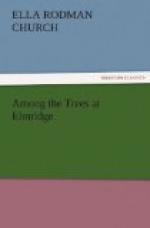“Hurrah for the white pine,” said Malcolm, with great energy, “the grand old American tree!”
“I’m glad that the little birds and animals have such a nice home under it in winter,” said Clara.
“I’m glad too,” added Edith, “but I wish we could find some and see how they look in their soft bed. Don’t they ever put their heads out the least bit, Miss Harson?”
“Not when they suspect that there is any one around, dear, and the little creatures are very sharp to find this out. Our heavenly Father, you know, takes thought for sparrows and all such helpless things, and they are fed and cared for without any thought of their own.—The white pine,” she continued, “is truly a magnificent tree, but I think we shall find that the pitch-pine is also very useful.”
“That’s the rough one,” said Malcolm; “I remember how it looks, with little tufts sticking out along the trunk.”
“Yes,” replied his governess, “and out authority says this tree is distinguished by its leaves being in threes—the white pine, you know, has them in fives—by the rigidity and sharpness of the scales of its cones, by the roughness of its bark, and by the denseness of the brushes of its stiff, crowded leaves. Its usual height is from forty to fifty feet, but it is sometimes much taller. The trunk is not only rough, but very dark in color; and from this circumstance the species is frequently called black pine. The wood is very hard and firm, and contains a quantity of resin. This is much more abundant in the branches than in the trunk, and the boards and other lumber of this wood are usually full of pitch-knots.”
“What are pitch-knots?” asked Clara.
“‘When a growing branch,’” read Miss Harson, “’is broken off, the remaining portion becomes charged with resin,’ which is deposited by the resin-bearing sap of the tree, ’forming what is called a pitch-knot, extending sometimes to the heart. The same thing takes place through the whole heart of a tree when, full of juice, its life is suddenly destroyed.’ ‘Resin’ is another name for turpentine, but is used of it commonly when hardened into a solid form. The tar is obtained by slowly burning splintered pine, both trunk and root, with a smothered flame, and collecting the black liquid, which is expelled by the heat and caught in cavities beneath the burning pile. Pitch is thickened tar, and is used in calking ships and for like purposes.”




